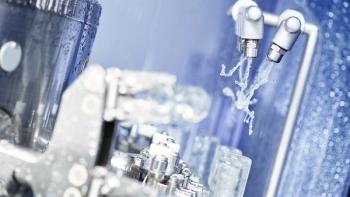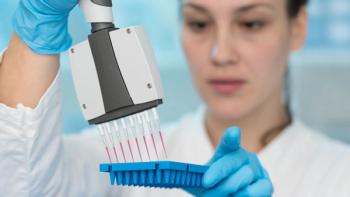
- BioPharm International-02-01-2013
- Volume 26
- Issue 2
Automated Concentration and Diafiltration of Multiple siRNA Samples
Project: transfer a manual concentration/diafiltration process for siRNA production.
ABSTRACT
The use of small-interfering RNA (siRNA) oligonucleotides for post-transcriptional gene silencing has proven to be an effective and powerful tool in the discovery of gene function. Of particular interest to drug discovery is the application of siRNA as a biotherapeutic agent (1–5). To evaluate the suitability and effectiveness of siRNA as a biotherapeutic product, it is of interest to generate multiple targets and screen for the desired function. The generation of many variants as candidates requires robust processes for screening to aid in selecting the optimum siRNA candidate. Automation of the production and screening processes has the inherent advantage of rapidly and systematically analyzing large sample quantities. A team of scientists from GE Healthcare collaborated with Merck scientists on a project to transfer a conventional manual concentration/diafiltration process for siRNA production using three filtration systems to an optimized, automated process using two ÄKTAcrossflow filtration platforms. The project output based on automated process hardware and software configurations significantly reduced operator requirements while increasing throughput of siRNA samples by 40% (from 6 per day to 10 per day).
Controlled, systematic, quality small-interfering RNA (siRNA) production is the core of any successful RNA therapeutics program. To effectively screen potential targets for in vivo activity, it is necessary to create an optimized workflow at the appropriate scale, capable of delivering 100 unique siRNA duplex targets per month. Creating effective workflow capabilities that produce multitudes of unique compounds at scales ranging from milligrams to grams levels requires efficient and flexible use of equipment and personnel. The synthesis and purification unit operations of the process utilize equipment with programmed methods allowing scientists to complete their respective tasks. Manual crossflow filtration (CFF) steps of the process lacked process robustness and were a source of variation between production runs. The project objective was to streamline the process to improve process efficiency and productivity while improving product quality.
(PHOTO CREDIT: ISTOCKPHOTO/THINKSTOCK SOURCE)
PROCESS DESCRIPTION
The production of RNA oligonucleotides in the process workflow begins with chemical synthesis using the ÄKTAoligopilot platform to create single-stranded RNA (ssRNA) products (see Figure 1). Each synthesizer has the capacity to synthesize two oligomers, typically 6500 KD to 7500 KD in size, per 24-hour cycle at scales ranging between 10 μmol to 800 μmol. Following a manual deprotection of the siRNA product, reversed-phase high-performance liquid chromatrography (RP-HPLC) and liquid chromatography–mass spectrometry (LC/MS) are used to analyze the quality of the starting feed material and to assign lot specifications for further downstream purification.
Figure 1: Schematic process workflow for siRNA production.
The ssRNA product is purified using an anion-exchange chromatography run on a preparative scale LC system with an automated fraction collector, allowing the purification of multiple samples. After screening of collected fractions, the final pool is analyzed for purity by RP-HPLC and quantified using optical density at 260 nm. Typical results for a 200 μmol synthesis are volumes of 0.6–2 L with concentration ranging 0.5–1 mg/mL in the final samples.
The purified ssRNA product is then transferred for duplexing of complementary strands to create siRNA product. Once the duplex is confirmed to have minimal excess of either single strand, the siRNA product requires diafiltration and concentration using ultrafiltration methods. These methods remove residual salt and reduce the volume adequately for lyophilization. In this process, a 200 μmol RNA synthesis reaction and subsequent downstream purification can produce product in the range of 150–1000 mg of final lyophilized siRNA product.
EXPERIMENTAL METHOD
To implement the automation strategy for concentration and diafiltration, the following equipment reconfigurations were performed:
1) the air sensor was moved from transfer inlet 1 to the common transfer valve block outlet
2) a fraction collector was added to retentate outlet 3 to allow for multiple sample processing
3) the inlet ports on the ÄKTAcrossflow system were reassigned in the method.
Transfer inlet configuration. The system air sensor controlled sample volumes processed across all inlets. Water from a hydro purification system was used for rinsing, water flux test, flush, and diafiltration steps. Water was used to condition the filter. The modified inlet configuration is shown in Figure 2.
Figure 2: ÃKTAcrossflow modified transfer inlet configuration enabling automated multiple sample processing.
Fraction collector configuration. The Frac-920 fraction collector was programmed to collect five fractions for each sample processed. The collection sequence was programmed as shown below:
Tube 1: Reservoir volume at product end
Tube 2: Product chase
Tube 3: Reservoir volume at buffer flush end
Tube 4: Flush chase
Tube 5: Fraction collector tubing clean via 25 mL buffer flush.
Merck reported that there were no cross contamination issues with their samples using the 25 mL buffer flush as determined by HPLC analysis.
Method configuration. The ÄKTAcross-flow method wizard in the UNICORN software was used to create the initial method framework, including the pre- and postproduct steps (see Figure 3). Scouting was enabled to vary the sample inlet used for each run. The ÄKTAcrossflow method was modified to prevent the loading of the subsequent sample onto a fouled filter. This was achieved with inclusion of the flux drop calculation mode, combined with conditional programming on the percent flux drop. Pre- and postwater flux test results were compared within the same run. If the percent flux drop, as set by the user, was outside the threshold, a message would appear on screen for the user to take action while the system entered into a hold state with the permeate outlet in recycle mode. The goal of the method was two-fold—firstly, to concentrate the product to the minimum working volume, and secondly, to remove as much salt as possible.
Table I: The product step endpoints.
Starting volumes were typically 0.6–2 L [5–20 OD/mL]. The system holdup volume (recirculation loop including filter) was 45 mL. The molecular weight cut-off for the membrane filters was 1 KD and the membrane surface area was 1 ft2. The product step endpoints were as shown in Table I.
Figure 3: Flow scheme of ÃKTAcrossflow system. The air sensor is moved from transfer inlet 1 to the common transfer outlet. The fraction collector is connected at the retentate valve block 3 outlet for product recovery.
An example of the method scouting setup in the UNICORN software is shown in Figure 4. User configured options are available each time a set of samples is processed with the same method. Parameters such as sample inlet and sample volume are updated as needed for each sample set. Parameters that are identical for each sample, such as diafiltration endpoint and flux drop percent, can also be shown for verification of status.
Figure 4: UNICORN scouting method setup. Sample names have been removed to protect proprietary information.
RESULTS
Up to five samples/day/system were processed with start up time of less than one hour. The chromatogram in Figure 5 illustrates a portion of the data observed for the processing of a siRNA sample. Event marking indicates the various segments of the method run. The curve data track and record all information in an electronic record. Curve data not depicted are automatically included in the result file and can be presented at a later date if desired.
Figure 5: Example siRNA DF screening result. Left axes are ConcFactor in blue and DF X Factor in red. Right axes are LMH in green and Feed Pressure in blue. DF=diafiltration factor, LMH=permeate flux (L/m2/hour).
CONCLUSION
Automating the ultrafiltration step of siRNA production increased the overall productivity of the group by 40% and reduced the necessary manpower required for the project from two full-time employees (FTEs) to one. The 40% improvement was a result of being able to process 10 samples/day on two automated systems compared with the previous approach of processing two samples/day on three manual systems (see Table II).
Table II: Advantages of automated versus manual system setup. FTE is full-time employee.
These improvements allowed for overall cost savings while increasing the number of samples available for research. By utilizing the instructions available in the UNICORN software for the ÄKTAcrossflow platform, a safety measure was incorporated into the method to prevent loading sample onto a fouled filter, reducing the risk of product lost and failed experiments. The ÄKTAcrossflow system has proven to be suitable for automated multiple sample processing using standard software and hardware with minimal operator interaction, demonstrating an efficient means to improved process robustness.
Rebecca Arvary is a research chemist at Merck Research Labs, Merck & Co, RY818-B221, PO Box 2000, Rahway, NJ 07065 USA. *Deborah R. Cohen is a senior scientist of Fast Trak, Steven Vaughan is a field applications consultant, and Catherine Blake is a product specialist-filtration, all at GE Healthcare Life Sciences, 800 Centennial Avenue, Piscataway, NJ 08854 USA.
*To whom all correspondance should be addressed
PEER-REVIEWED
Article submitted: Aug. 22, 2012. Article accepted: Oct. 12, 2012.
REFERENCES
1. T. Tokatlian and T. Segura, WIREs Nanomed. Nanobiotechnol. 2 (3), 305–315 (2010).
2. R.S. Pellish et al., Pharmacol. Ther. 27 (9), 715–723 (2008).
3. O. Pontes and C.S. Pikaard, Curr. Opin. Genet. Dev. 18 (2), 197–203 (2008).
4. M. Schlee et al., Mol. Ther. 14 (4), 463–470 (2006)
5. M. Ichihara et al., Nucl. Acids Res. 35 (18), e123 (2007).
Articles in this issue
over 12 years ago
BioPharm International, February 2013 Issue (PDF)over 12 years ago
Assessing Development Needs for Biobetters and Biosimilarsover 12 years ago
Facility Design and Operation: A Primerover 12 years ago
Offering a Biopharma View of Social Mediaover 12 years ago
GMP Compliance Becomes Prominent Enforcement Issueover 12 years ago
Therapeutic Antibodies in Reviewover 12 years ago
The Vaccine Sceneover 12 years ago
End of the Dedicated CMO?over 12 years ago
Viral Vaccine Manufacturingover 12 years ago
Navigating Emerging Markets: Eastern EuropeNewsletter
Stay at the forefront of biopharmaceutical innovation—subscribe to BioPharm International for expert insights on drug development, manufacturing, compliance, and more.





